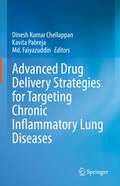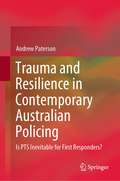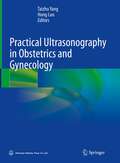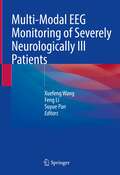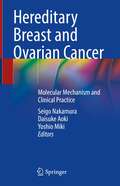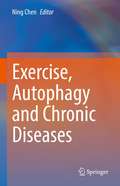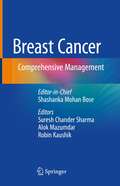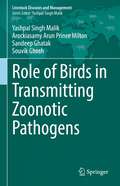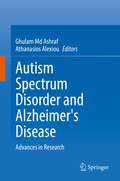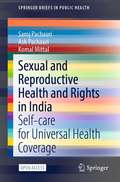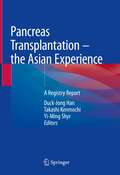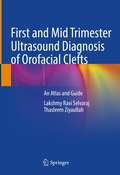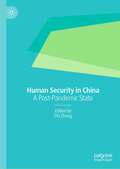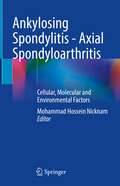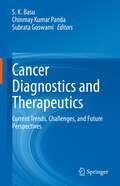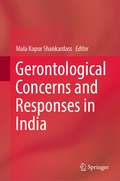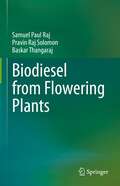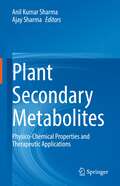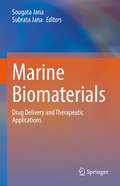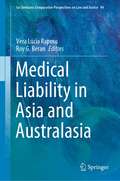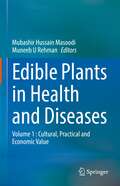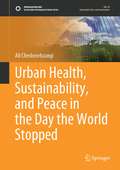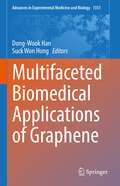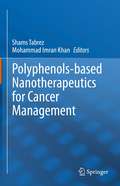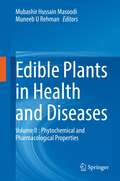- Table View
- List View
Advanced Drug Delivery Strategies for Targeting Chronic Inflammatory Lung Diseases
by Dinesh Kumar Chellappan Kavita Pabreja Md. FaiyazuddinThis book describes the growing clinical and healthcare relevance of nano-therapeutics in treating respiratory diseases. It begins with a brief introduction on the different types of nanoparticles in respiratory disease conditions. It further discusses the current trends in understanding the disease pathology using different in vitro and in vivo models, which are important towards the onsite clinical applications and development of new therapeutics. The book includes exciting topics such as formulation of these nanoparticles, targeting various organelles etc. It also describes the future prospects and challenges in the field. Different chapters are written by researchers actively working in the area of pulmonary diseases. This book is designed to address the requirements of both beginners and specialized scientists involved in pulmonary research. The contents include basic concepts followed by advanced state-of-art monitoring and treatment of diseases. The book is meant for researchers and industry experts in nanotechnology, pharmaceutical sciences and drug design.
Trauma and Resilience in Contemporary Australian Policing: Is PTS Inevitable for First Responders?
by Andrew PatersonThis book examines how fifty police officers in South Australia keep well and “bounce back” from duty-related traumatic experience in the absence of practical, accessible and timely organisational support. It investigates mechanisms police officers presently use to “normalise” their duty-related traumatic experiences to preserve the delicate professional balance between “coping” and “psychic numbing” and avoid the much publicised perils of a PTSD diagnosis, while being appropriately responsive to colleagues, victims and survivors in their daily work environment. By revealing how police officers manage trauma—outside of the expectations of mental health professionals, union representatives and police leadership—innovative approaches and recommendations are offered to support first responders in moving from assumptions of post-traumatic stress and through post-traumatic growth. The book considers recent advances in post-traumatic growth and resilience theory and reinterprets exposure in a positive context, as well as preventative experiences in Australia and internationally.
Practical Ultrasonography in Obstetrics and Gynecology
by Hong Luo Taizhu YangWith rapid development of ultrasound technology, its clinical application is expanding and deepening. This book is focused on practical application of ultrasound in obstetrics and gynecology. Besides ultrasound diagnosis, the new progress of ultrasound in obstetrics and gynecology, such as interventional ultrasound, 3D ultrasound, and endoscopic ultrasonography, is also discussed. Typical images selected from abundant cases are provided with concise and refining key points. It serves as a valuable reference for sonologists, radiologists and gynaecologists for accurate diagnosis.
Multi-Modal EEG Monitoring of Severely Neurologically Ill Patients
by Xuefeng Wang Feng Li Suyue PanThis book provides practical information on applications of multi-modal EEG monitoring in patients with severely neurologically diseases. The First part systematically introduces the modern EEG techniques, and multi-modal EEG monitoring system for severe neurological illness. In the second part, identification of EEG artifacts and interpretation of common abnormal EEG patterns is presented. Accompanying more than 50 typical cases and 200 EEG records, the following chapters discusses EEG’s changes and clinical significance in coma, ischemic-hypoxic encephalopathy, status epilepsy, Creutzfeldt-Jakob disease, traumatic brain injury, and other diseases in details. In addition, application of multi-modal EEG in monitoring intracranial pressure and predicting suicide risk is also included. It will be a valuable reference for professionals in neurology, neurosurgery, emergency care, psychiatry, technology specialists of EEG and senior nurses with basic EEG monitoring knowledge.
Hereditary Breast and Ovarian Cancer: Molecular Mechanism and Clinical Practice
by Seigo Nakamura Daisuke Aoki Yoshio MikiThis highly informative and clearly written book presents the basic science and the latest data on hereditary breast and ovarian cancer (HBOC) to provide an up-to-date and holistic overview of the disease. It starts off by presenting the molecular mechanisms, genetic testing and counseling, and variants of unknown significance (VUS) to help readers understand the contemporary interpretation of the disease. Further chapters focus on the surveillance, diagnosis and treatment, including chemoprevention, risk reduction and drug development based on molecular mechanisms. It also includes a chapter on the latest findings from the HBOC database, ethical issues and the parp inhibitors, and discusses innovative thinking to manage and understand the disease. Hereditary Breast and Ovarian Cancer - Molecular Mechanism and Clinical Practice offers breast surgeons, medical oncologists, gynecological oncologists and genetic counselors a comprehensive overview of the disease. Providing insights into recent scientific findings and further avenues for investigation, it is also a thought-provoking and informative read for researchers and scholars.
Exercise, Autophagy and Chronic Diseases
by Ning ChenThis book establishes a bridge between exercise-mediated functional status of autophagy and non-communicable chronic diseases for elucidating and clarifying the corresponding signal pathways and underlying mechanisms. The book consists of 13 chapters focusing on the in-depth discussion on signal pathways for regulating the functional status of autophagy for the prevention, treatment and rehabilitation of chronic diseases, the optimization of exercise intervention strategies for common and frequently-occurring chronic diseases, and the development of exercise mimetic pills for the persons with disability for exercise performance, or the persons without willing to exercise. This book is interesting and will be useful to a wide readership in the various fields of exercise science, exercise fitness, sports medicine, preventive medicine, and functional foods.
Breast Cancer: Comprehensive Management
by Shashanka Mohan BoseThe book provides detailed information on breast cancer and covers all the aspects of this rapidly spreading disease, such as applied anatomy and physiology, causative factors, various Investigations to reach a concise, definitive and complete diagnosis. The management of breast cancer involves multi-modality treatment and the book describes all the modalities in a very clear manner. It also discusses in a very lucid and practical way. the multi-prong treatment that the patient requires . Additionally, the book covers lesser-known areas of the subject like rehabilitation, management of lymphoedema, Extravasation of chemo-Infusion, organization of breast cancer management group, breast cancer awareness and patient education, follow up of the patient, and psychological support to these patients who have undergone mutilation of their organ. Edited by experts the chapters are contributed by renowned onco-sugeons from high volume and reputed centers in India such as, PGIMER, Chandigarh, AIIMS, New Delhi, and TMH, Mumbai among others. The book serves as a useful resource for surgeons, medical oncologists, radiotherapists, pathologists, radiologists and many other specialists interested in the field of breast cancer and actively working in this area. It is useful for practitioners and residents as well as for those who want to learn the different aspects of this disease.
Role of Birds in Transmitting Zoonotic Pathogens (Livestock Diseases and Management)
by Yashpal Singh Malik Arockiasamy Arun Prince Milton Sandeep Ghatak Souvik GhoshZoonotic diseases pose a serious threat to global health and economy. Domestic and wild birds play crucial roles in transmission and spread of important zoonotic pathogens, with significant implications on human and avian health. Although zoonotic diseases have been extensively studied, information on various aspects of avian zoonotic pathogens have not been revisited or revised to any great extent. This book is a comprehensive and updated compilation of important zoonotic diseases that are transmitted by domestic and wild birds, and consists of 21 chapters that meticulously describe the (i) etiology and evolution, (ii) complex epidemiology, such as migration pathways in context of disease transmission, (iii) pathogenesis, (iv) clinical signs and necropsy findings, (v) diagnostics including latest molecular assays, and (vi) preventative and control strategies, with an emphasis on therapeutics and prophylaxis, of important zoonotic pathogens (bacterial, fungal, parasitic and viral) of avian origin in humans and birds. Each chapter is aptly supported by interactive tables and figures, and features an updated reference section. This book aims to create awareness and enlighten students of veterinary and human medicine on the role of birds in zoonoses, and would serve as a useful reference for working veterinarians, human doctors, and public health experts.
Autism Spectrum Disorder and Alzheimer's Disease: Advances in Research
by Athanasios Alexiou Ghulam Md AshrafThis book talks about the multidimensional biological etiology of Alzheimer’s disease and autism spectrum disorder which leads to distinctive ways of perception, thinking and learning in affected individuals. It provides a deeper emphasis on the need for early diagnosis, continuous assessment of patients and the proper educational methods and environment required towards enabling people affected with these disorders capable of evolving and learning.This book explores alternative solutions for autism spectrum disorder based on the theory of brain plasticity, the relationship between the gut microbiota and the central nervous system along with genetic factors and toxic metal exposures which are responsible for the oxidative damage resulting in a decreased ability of the patients to use objects or response to auditory stimuli. It also identifies and provides the latest research towards dealing with memory loss, which is the first sign of cognitive impairment followed by behavioral disturbances. These symptoms are associated with a rigorous neuronal decline and the appearance of two brain lesions, senile plaques and neurofibrillary tangles, which are mainly composed of Aβ and hyper phosphorylated tau protein respectively. This book also provides the latest research towards reducing autism disorder severity such as targeting the disease with symptomatic treatments such as cholinesterase inhibitors, NMDA receptor antagonist, β-secretase and γ-secretase inhibitors, α-secretase stimulators, tau inhibitors, immunotherapy, nutraceuticals, and nano drugs.This book will not only be a good resource for professors and lecturers teaching in the area of neuroscience, medicine, biochemistry, neuroinformatics, and nanotechnology, etc. but also for professionals working in the field of occupational therapy and geriatric clinics and rehabilitation.
Sexual and Reproductive Health and Rights in India: Self-care for Universal Health Coverage (SpringerBriefs in Public Health)
by Saroj Pachauri Ash Pachauri Komal MittalThis open access book addresses self-care on sexual and reproductive health and rights and HIV prevention and treatment in the most marginalized and vulnerable communities. Case studies and personal narratives are used to share their perspectives and experiences, sources of information for self-care products, motivations for self-care, and challenges and outcomes. Self-care provides the way to reach the last mile in achieving universal health coverage and the Sustainable Development Goals. Issues related to stigma, discrimination and violence among these communities are highlighted. Changes in policies and programs to improve their sexual and reproductive health, education and employment are discussed. The last chapter in the book examines how the agenda on self-care can be advanced in the years ahead. The audience for this publication includes health professionals, researchers, those managing health institutions and service providers.
Pancreas Transplantation – the Asian Experience: A Registry Report
by Takashi Kenmochi Duck-Jong Han Yi-Ming ShyrThis book is the first to provide a thorough overview of the experience of pancreas transplantation in Asian countries, including in particular Korea, Taiwan, and Japan. Recent trends are identified and attention drawn to differences in comparison with the United States and Europe. Such differences relate, for example, to the history of pancreas transplantation, the operative procedure, and the organ-sharing system. In addition, the insulin-secreting ability of pancreatic islet cells is thought to vary depending on race. Beyond these aspects, the coverage also encompasses ABO-incompatible living donor pancreas transplantation, which is very rarely performed elsewhere in the world. By introducing the number, technique, and outcomes of pancreas transplantation in Asian countries, the book will hopefully further stimulate the pancreas transplantation program in this region and beyond. It will be of value for all medical professionals in the field and will be informative for diabetic patients receiving insulin treatment in Asia.
First and Mid Trimester Ultrasound Diagnosis of Orofacial Clefts: An Atlas and Guide
by Lakshmy Ravi Selvaraj Thasleem ZiyaullahThis book aims to highlight all the existing information available on first and mid-trimester imaging of palate in prenatal ultrasound and to develop a methodical approach in imaging the palate. As formation of the palate is completed by 11 weeks of gestation and as there are no evolving changes in palatine anatomy at the mid-trimester, diagnosis of palatine clefts can now completely be shifted to late first-trimester. First-trimester evaluation of palate is now gaining importance and a number of techniques have currently been proposed by different authors.This book covers the existing literature and recent 2D and 3D techniques in evaluating palate and helps in the early detection of palatine clefts in the first trimester. Orofacial clefting is one of the most common birth defects and the burden of it in developing countries is substantial. This book helps in improving the counseling options for the obstetrician and the couple early in gestation. It includes 2D and 3D images of various types of palatine clefts and the nuances in imaging the secondary palate extensively. 3D images of the palate also help the multi-disciplinary team especially the maxillofacial surgeons involved in managing orofacial clefts. It also includes videos for easy understanding.This book is a ready reckoner for the imaging specialists and students /trainees involved in prenatal diagnosis. It provides essential information in diagnosing orofacial cleft both to the novice and to the skilled professionals involved in the field of diagnostic fetal ultrasound.
Human Security in China: A Post-Pandemic State
by Chi ZhangThis book explores the emergent concept of 'human security' within the political context of COVID-19 Chinese politics. For decades, Western nations have used 'human rights' as a rubric with which to scold Chinese leaders, betraying a fundamental unwillingness to accept diversity of governance systems. As COVID-19 has demonstrated, different governance systems yield different outcomes—the freedom of circulation, speech and movement in Western democracies yielding one, and use of surveillance, lockdowns, and private–public collaboration in China and Asian societies such as Korea and Singapore yielding another. Chinese political scientists have become fixated on the notion of 'human security,' a utilitarian concept which insists on the importance of protecting and extending human life via health care, technology, and a wide range of other systems—sometimes, in ways which contradict Western notions of human rights, even as they demonstrably achieve superior outcomes for the humans involved. Being the first English language book to explore these issues, this book aims to generate a sustained theoretical relevance in the aftermath of the crisis which is likely to have lasting effects on how people live and will be of note for political scientists, China scholars, and economists.
Ankylosing Spondylitis - Axial Spondyloarthritis: Cellular, Molecular and Environmental Factors
by Mohammad Hossein NicknamAnkylosing Spondylitis is a chronic autoimmune disease that affects about 1-3% of the world population. This debilitating disease affecting primarily young males exerts considerable socio-economic consequences. The exact pathogenesis of AS has not yet been fully understood; therefore, novel, detailed information sources are required. This book offers cutting-edge knowledge about the molecular basic and immunological mechanisms involved in the pathogenesis of Ankylosing Spondylitis. It is one of the scarce scientific resources discussing the environmental factors triggering the disease, along with the clinical manifestations, diagnostic methods, and treatments. This book covers the most recent and reliable researches and developments about spondyloarthropathies in order to provide elaborated, integrated guidance on the molecular mechanisms of Spondyloarthropathies. It will prove helpful for rheumatologists, immunologists, biologists, geneticists, and medical science students who wish to learn more about SpAs.
Cancer Diagnostics and Therapeutics: Current Trends, Challenges, and Future Perspectives
by S. K. Basu Chinmay Kumar Panda Subrata GoswamiThis book presents multiple facets of cancer biology, including cancer diagnosis, therapeutics to the latest developments in cancer informatics, and applications of artificial intelligence for improving oncologic care. The initial section of the book discusses factors contributing to the development and causes of cancer. The subsequent sections discuss the basic principle of imaging and therapeutic techniques, including MRI, CT, and positron emission tomography (PET) Scan. The book further, explores the implications of cancer chemotherapy on the immune system and emphasizes the effective management of cancer-related pain. Towards the end, it covers recent advancements in cancer treatment, including targeted therapy, immunotherapy, interventional radiotherapy, and stem cell-based therapy. Lastly, it summarizes essential strategic elements of cancer informatics for improving patient outcome.
Gerontological Concerns and Responses in India
by Mala Kapur ShankardassThis book discusses gerontological issues and challenges impacting the quality of life of older people in India. The chapters provide different disciplinary insights ranging from sociology, anthropology, psychology, health sciences, social work, demography, gender, and legal perspectives. The chapters are written by experts and practitioners in the field bringing focus to new gerontological insights from an academic and an empirical perspective. It engages the reader with the growth of different branches of gerontology along with concerns faced by older people. It brings attention to concerns related to ageing of the population in different parts of the country, such as among the tribes, the LGBT community, and conflict zones. It highlights gender aspects related to health care and discusses policy responses, strategies to empower older persons, the role of voluntary organizations, issues related to caregiving and family bonding, and aspects of social protection for the older people. It offers a valuable resource for researchers, academics, practitioners, and policymakers in the areas of gerontology, demography, and sociology, as well as all those interested in the study of ageing populations.
Biodiesel from Flowering Plants
by Samuel Paul Raj Pravin Raj Solomon Baskar ThangarajThis book offers an exhaustive coverage of process modifications in biodiesel production from oil drawn from 84 oleaginous plant species occurring in all parts of the world, thereby enlisting the scope and potential of many new and non-conventionally obscure plant sources. Biodiesel, now prepared from major vegetable oils, has become a compulsion to offset the dwindling reserve of petro-diesel, which naturally intrudes into the cooking oil demand. This has necessitated search for new sources. The book consolidates the biodiesel production from oils being extracted from conventional plants and also from a plethora of new and non-conventional plants along with their habit and habitats, history of biodiesel’s invention, explanation on species-wise biodiesel process variables, catalytic inclusions, global standards, fuel properties varying with species, blending benefits, cost effectiveness, shelf life, ignition characteristics, fuel consumption and engine performances with eco-friendly exhaust. This book is of immense use to teachers, researchers, scientists of climatology and carbon footprint, energy consultants, fuel chemists, students of agriculture and forestry, automobile engineering, industrial chemistry, environmental sciences and policy makers or anyone who wishes to scale up the biodiesel industry.
Plant Secondary Metabolites: Physico-Chemical Properties and Therapeutic Applications
by Ajay Sharma Anil Kumar SharmaPlant secondary metabolites are plant-based natural products that display a variety of pharmacological effects. This book discusses the invaluable bioactivity and multifaceted potential of these compounds. The book describes the physico-chemical and biochemical aspects of the plant secondary metabolites along with the chemistry, therapeutics and future perspectives of these plant secondary metabolites. Moreover, the book also discusses about various sources of plant secondary metabolites, and the metabolite determination through various analytical techniques. It further describes the potential applications of plant secondary metabolites as anticancer and chemo preventive agents, their role as cosmetic ingredients and activity in skin cancer therapy. Further chapters emphasize upon the plethora of roles of plant secondary metabolites, including those as antivirals, anti-bacterial, anti-inflammatory drugs, cardioprotective agents etc. The book culminates with chapters on the impact of certain plant secondary metabolites in plant defence and human healthcare. This book is meant for researchers and students in the field of pharmacology and plant sciences. Moreover, this book is also useful for industry experts especially working in the field of herbal therapeutics.
Marine Biomaterials: Drug Delivery and Therapeutic Applications
by Sougata Jana Subrata JanaThis book is focused on marine based biomedical carriers for delivery of therapeutics. Marine biomaterials and bio-based carriers show wide applications in pharmaceutical as well as biomedical fields for delivery of small and large molecules. Biomaterial-based composites, scaffolds or matrix systems are promising systems for controlled and prolonged release of drug in target site and control the premature release of drugs or bioactive compounds. This book discusses the targeted delivery of drugs and therapeutic applications. It also describes the use of marine biopolymers in cancer therapy. Different chapters describe the tissue engineering techniques to develop these carriers. The marine biomaterial-based systems are widely used for tissue engineering, and biomedical imaging. This book is meant for industry experts, students and researchers in the area of pharmaceutical sciences, biomedical engineering and material science and pharmacology.
Medical Liability in Asia and Australasia (Ius Gentium: Comparative Perspectives on Law and Justice #94)
by Vera Lúcia Raposo Roy G. BeranThis book brings together some of the most respected Asian and Australasian experts on medical liability to provide insightful perspectives on civil and criminal law from selected Australasian jurisdictions. It focuses on the idiosyncrasies of the existing law and case law in this part of the world with regard to medical liability, adopting a comparative and critical perspective. The aim is to provide an overview of the basic elements of medical liability in Asian and Australian jurisdictions, as well as the latest developments and general trends in jurisprudence.Given the broad range of jurisdictions covered, the book offers lawmakers, health administrators and practitioners, both in law and medicine, an alternative approach to the delivery of health care. Further, it is essential reading for all those (academics, lawyers, judges, researchers, practicing doctors and those involved in the growing area of legal medicine) working in medical liability, specially in the Australasian context.
Edible Plants in Health and Diseases: Volume 1 : Cultural, Practical and Economic Value
by Mubashir Hussain Masoodi Muneeb U RehmanThe book provides significant information on some of the promising edible medicinal plants and how these possess both nutritive as well as medicinal value. The significance of these edible plants in traditional medicine, their distribution in different regions and the importance of their chemical constituents are discussed systematically concerning the role of these plants in ethnomedicine in different regions of the world. The current volume focuses on the economic and culturally important medicinal uses of edible plants and a detailed survey of the literature on scientific researches of pharmacognostical characteristics, traditional uses, scientific validation, and phytochemical composition, and pharmacological activities. This book is a single-source scientific reference to explore the specific factors that contribute to these potential health benefits, as well as discussing how to maximize those potential benefits. Chemists, food technologists, pharmacologists, phytochemists as well as all professionals involved with quality control and standardization will find in this book a valuable and updated basis for their work.
Urban Health, Sustainability, and Peace in the Day the World Stopped (Sustainable Development Goals Series)
by Ali CheshmehzangiThis book covers the nexus between urban health, sustainability, and peace. 'Urban Health, Sustainability, and Peace' is the first book that attempts to put these three critical areas together. This novelty approaches the subject matter by delving into evaluating what works, what does not work, and what should be done to achieve healthy cities. We believe this book will be beneficial to a wide range of stakeholders, particularly policymakers, planners, and developers, who continuously shape and reshape the structure and environments of our cities and communities. Unfortunately, in most cases, the healthiness of the cities may not be of their immediate concern. Nevertheless, it is the concern of the end-users, citizens, or simply those who live and work in cities and communities worldwide. To safeguard peace in cities, one has to consider sustaining urban health; and that is the main aim of this book. The ongoing pandemic gives us an excellent reason to study cities' health. During such a disruptive time, we detect many flaws in cities and communities around the world. We primarily identify the negative impacts on sustainability and peace in cities. In order to sustain a healthy city, this book evaluates six sustainability dimensions of physical, environmental, economic, social, institutional, and technical. It then utilizes eight primary dimensions of positive peace, evaluating critical areas for future considerations in urbanism. These considerations include making cities smarter, more resilient, and more sustainable. The book's ultimate goal is to highlight how we should progress to maintain and sustain urban health. As a continuation to 'The City in Need,', this book covers the nexus between urban health, sustainability, and peace. Furthermore, by reflecting on the ongoing pandemic crisis, metaphorically labelled as 'The Day the World Stopped,', we delve into some key areas beyond the usual planning and policy guidelines. Lastly, the book intends to highlight what has not been studied before, i.e., the relationship between urban health, sustainability, and peace.
Multifaceted Biomedical Applications of Graphene (Advances in Experimental Medicine and Biology #1351)
by Dong-Wook Han Suck Won HongThis book explains the fundamental characteristics and biofunctionality of graphene-based nanomaterials and provides up-to-date information on the full range of their biomedical applications. An introductory section gives an overview of the chemical composition and physical properties of graphene and its derivatives as well as their potential toxicity and biosafety. Detailed attention is then devoted to the potential of multifunctional graphene-based nanomaterials (MFGNs) to direct the differentiation of stem cells into specific lineages and induce tissue regeneration. Here, individual chapters address the application of MFGNs for the purposes of neurogenesis, osteo- and chrondrogenesis, myogenesis, and wound healing. Subsequent sections focus on the capability of MFGNs as agents for drug delivery, bioimaging, theranostics, and therapeutics as well as their effectiveness as biomimetic platforms for nanobiosensors, biochips, medical devices, and dental applications. The book will be essential reading for graduate students, scientists, and engineers in any of the biomedical research fields in which efforts are being made to utilize novel MFGN-incorporated composite materials and develop functional devices based on them.
Polyphenols-based Nanotherapeutics for Cancer Management
by Shams Tabrez Mohammad Imran KhanThis book reviews the applications of polyphenols in cancer treatment. The initial chapter of the book classifies different polyphenols and discusses their biological and chemical properties. The subsequent chapters then explore the diverse role of polyphenols in modulating signal transduction pathways in cancer including, cellular proliferation, differentiation, apoptosis, inflammation, angiogenesis, and metastasis. This book highlights the usefulness of polyphenol enriched seafood in modulating the anti-tumor and anti-inflammatory cytokine IFN-γ. The book also presents nanoformulation of polyphenol as a promising strategy for their enhanced bioavailability and targeted delivery. Lastly, the book examines the toxicity and safety evaluations of polyphenols as anticancer agents.
Edible Plants in Health and Diseases: Volume II : Phytochemical and Pharmacological Properties
by Mubashir Hussain Masoodi Muneeb U RehmanThe book provides essential information on some of the promising edible medicinal plants and how these possess both nutritional as well as therapeutic value. The significance of the edible plants in traditional medicine and the importance of the distribution of their chemical constituents are discussed systematically concerning the role of these plants in ethnomedicine in different regions of the world. The current volume deals with the individual plants' phytochemical and pharmacological properties, emphasizing human health. The title would demonstrate the value of natural edible plants and introduce readers to state-of-the-art developments and trends in omics-driven research. This book is a single-source scientific reference to explore the specific factors that contribute to these potential health benefits and discuss how to maximize those potential benefits. Chemists, food technologists, pharmacologists, phytochemists, and all professionals involved with quality control and standardization will find in this book a valuable and updated basis for their work.
